Overview
The article "9 Key Insights on Property Zoning Lookup Explained" emphasizes the significance and complexities inherent in property zoning lookup processes. It asserts that a thorough understanding of zoning regulations is essential for real estate professionals, enabling them to make informed decisions. These regulations profoundly impact property values, development potential, and adherence to local laws. The discussion is further supported by examples of technological advancements and case studies that illustrate the intricate nature of these processes.
Introduction
Understanding property zoning is essential for anyone involved in real estate, as it dictates how land can be utilized and developed. With the emergence of advanced technologies like Parse AI, the process of zoning lookup has become significantly more efficient, allowing professionals to swiftly access critical information that influences investment decisions and compliance. However, navigating the complexities of zoning regulations continues to pose challenges, raising questions about how to effectively leverage these tools while remaining informed about the ever-evolving laws. This article explores nine key insights that illuminate the intricacies of property zoning lookup, providing valuable guidance for real estate stakeholders.
Parse AI: Streamline Property Zoning Lookups with Advanced Machine Learning
Parse AI employs advanced machine learning algorithms to automate and accelerate the process of property zoning lookup explained. By analyzing extensive datasets of land use regulations and property records, the platform provides a property zoning lookup explained, effectively identifying relevant information and significantly reducing the time spent on manual searches. This efficiency proves particularly advantageous for real estate professionals who require rapid, informed decision-making.
Recent data from the Connecticut Zoning Atlas indicates that 55.2 percent of all mapped districts were recognized, underscoring the success of automated data collection initiatives. Furthermore, a partnership with Sara Bronin and the National Zoning Atlas seeks to enhance the automation of standardized land use data collection through text analysis and natural language processing techniques. The Urban Institute's Spatial Equity Data Tool (SEDT) also plays a pivotal role in enhancing data accessibility for users.
However, challenges remain, as illustrated by case studies that reveal the complexities of extracting standardized land use data from unstandardized documents. These studies advocate for a hybrid approach that merges human expertise with algorithmic methods. Additionally, land-use regulations significantly impact critical issues such as racial equity, housing affordability, and economic development, emphasizing the necessity of accurate land-use information for real estate professionals.
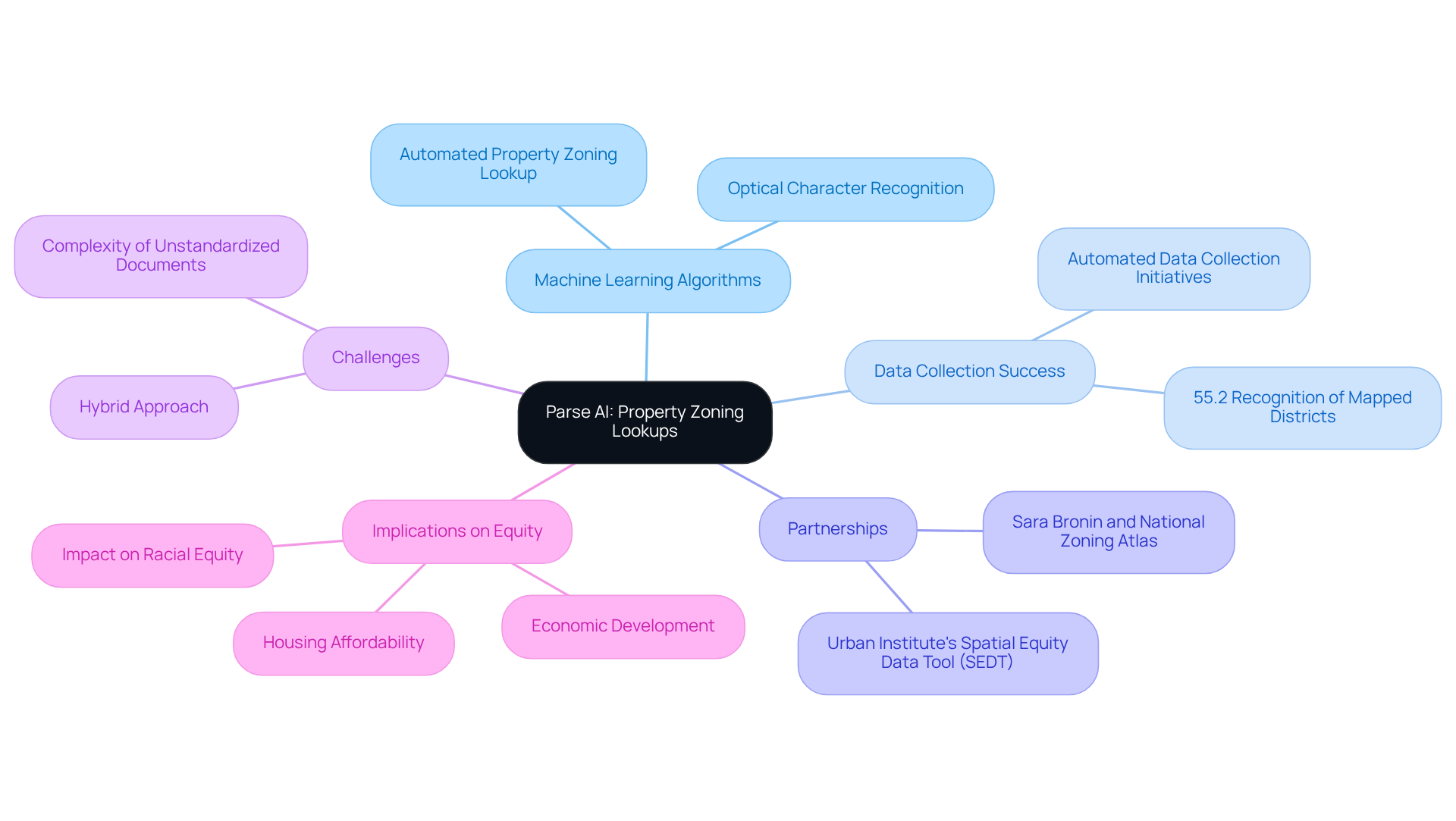
Zoning Districts: Key Areas to Identify for Accurate Property Research
Zoning districts represent designated areas within a municipality that dictate the permissible use of land. Grasping the significance of these districts is crucial for conducting accurate property zoning lookup explained, as they define allowable activities, building heights, and density. Realty experts must utilize the property zoning lookup explained to ascertain the land use classification of a property, ensuring compliance with local regulations and assessing its development potential. Furthermore, understanding these classifications empowers stakeholders to navigate the complexities of property development effectively.
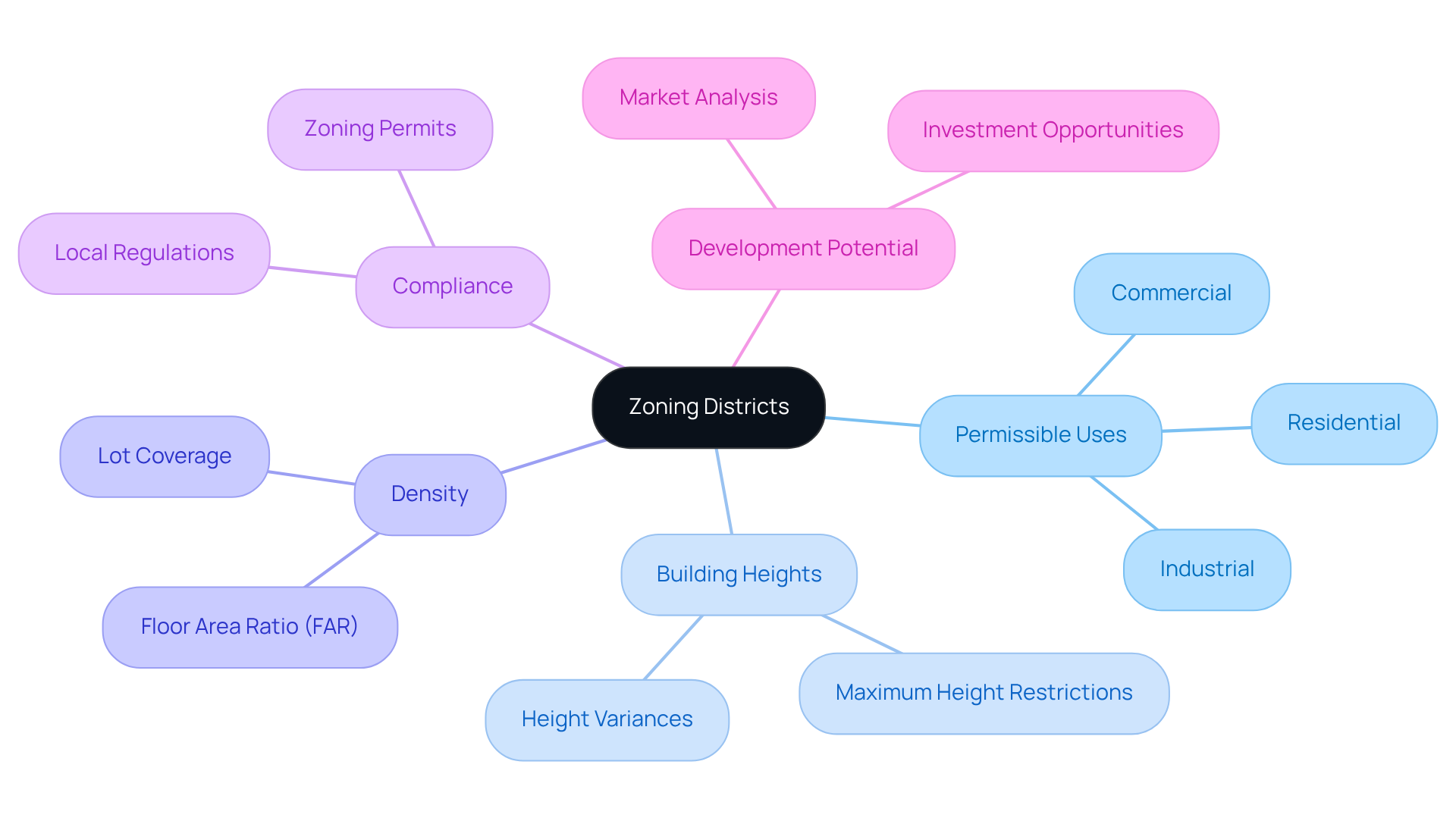
Zoning Regulations: Essential Guidelines for Property Compliance
The concept of property zoning lookup explained the zoning guidelines that serve as the framework for land use within designated districts, dictating essential parameters such as building setbacks, lot coverage, and allowable activities. Approximately 70% of real estate projects encounter some form of land-use policy, underscoring the necessity for experts in the field to fully comprehend these standards.
Familiarity with local land use regulations is crucial; understanding a property zoning lookup explained can help prevent significant legal disputes and financial penalties. A notable case in Virginia illustrates this point, where a developer faced legal action due to violations of land use rules, resulting in costly delays and modifications to the project.
Legal specialists emphasize that a comprehensive understanding of property zoning lookup explained is not merely beneficial but vital for successful property development. By adhering to these guidelines, property professionals can mitigate risks and ensure their projects align with community standards and expectations.
Furthermore, it is advisable for property professionals to regularly consult local planning boards or legal advisors to stay informed about any changes in regulations.
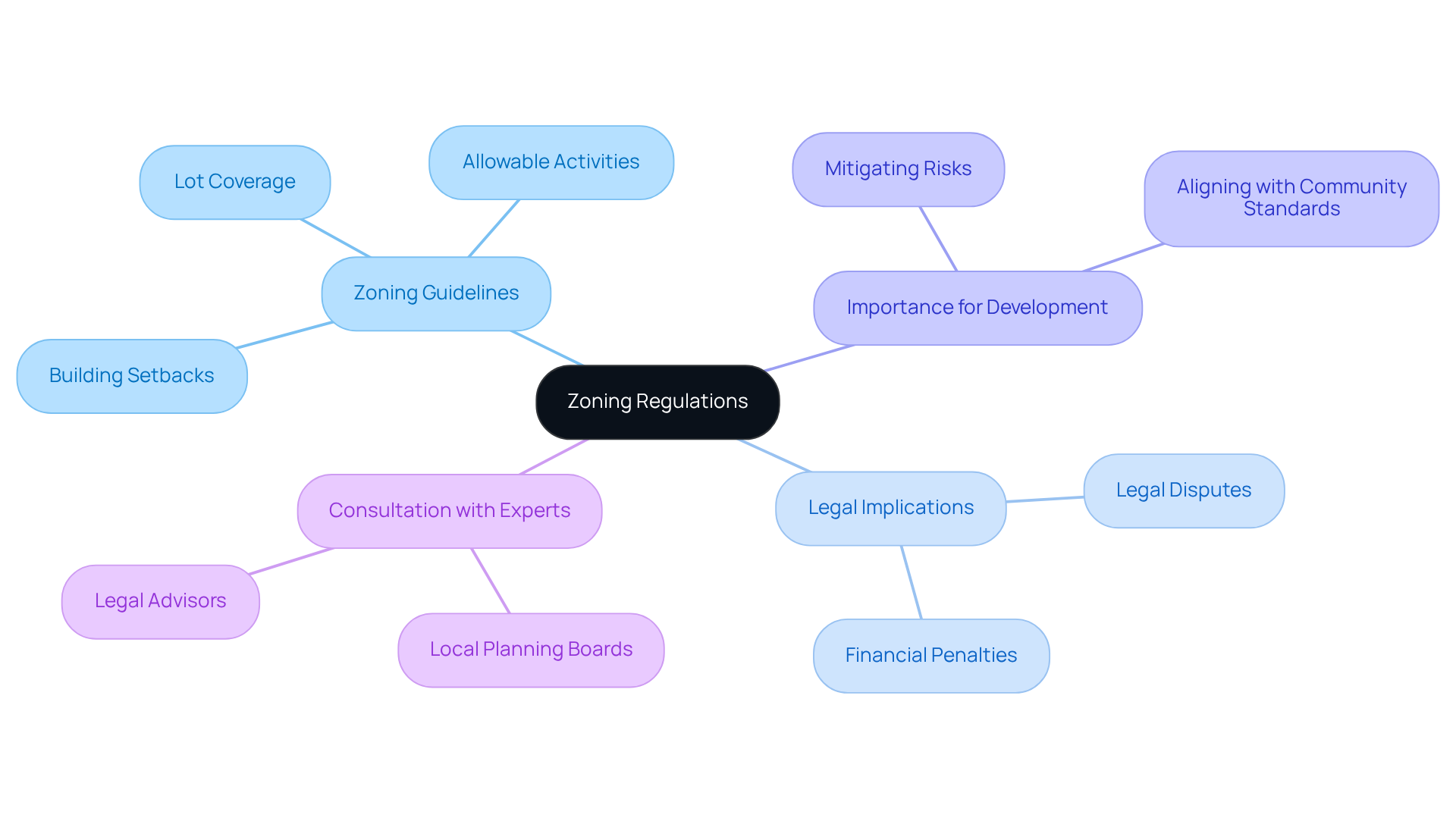
Development Standards: Analyzing Building Requirements in Zoning
Development standards encompass essential requirements pertaining to the design and construction of buildings, including:
- Height limits
- Parking specifications
- Landscaping guidelines
Understanding these standards is crucial for real estate professionals, as a property zoning lookup explained enables them to ascertain whether a property can support their intended use or development plans. Moreover, non-compliance with these standards can result in significant delays and costly modifications. Therefore, a thorough analysis of development standards is not merely advisable; it is imperative for successful project execution.
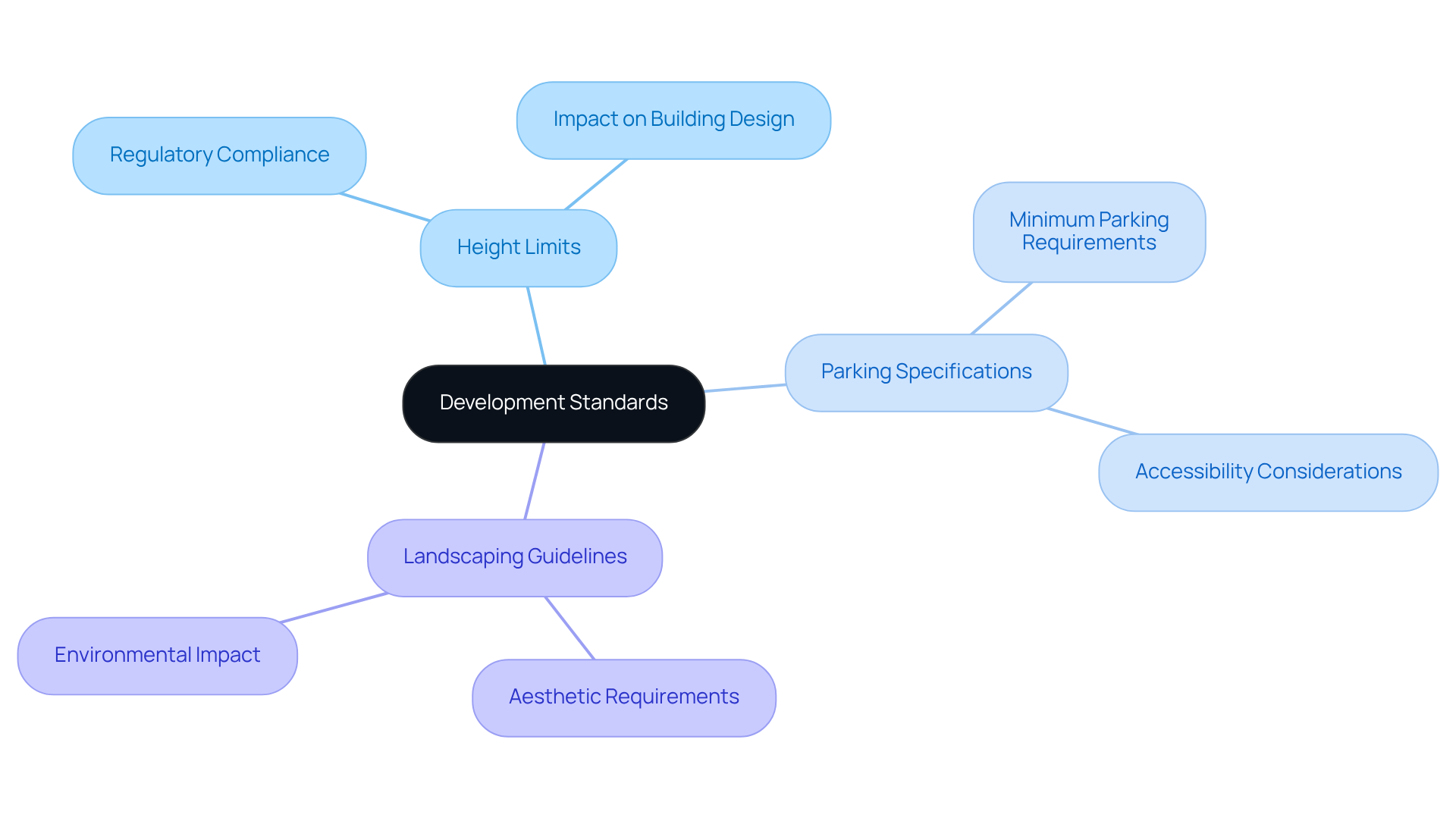
Overlay Districts: Understanding Additional Zoning Regulations
Overlay districts represent specialized zoning areas that impose additional regulations beyond those of the base zoning district. These guidelines may encompass:
- Historic preservation requirements
- Environmental safeguards
- Specific design criteria aimed at enhancing community character
For instance, the NCO Neighborhood Character Overlay mandates that over 75% of lots fulfill one or more criteria to foster a cohesive environment, significantly influencing construction decisions. Furthermore, recent amendments, adopted by the Charlotte City Council on June 16, further refine these guidelines to address unique geographical needs and public policy objectives.
A Certificate of Appropriateness is required for any exterior work in a historic district, and acquiring this certificate can lead to delays of up to 365 days if the property holds special significance. Successful projects, such as those under the RIO Residential Infill Overlay—which restricts residential building height to 20 feet—illustrate how navigating these additional zoning rules can result in compatible construction that respects existing neighborhood patterns.
Understanding these overlays is essential for realty professionals, as the property zoning lookup explained dictates compliance requirements and influences the future of property construction in affected areas.
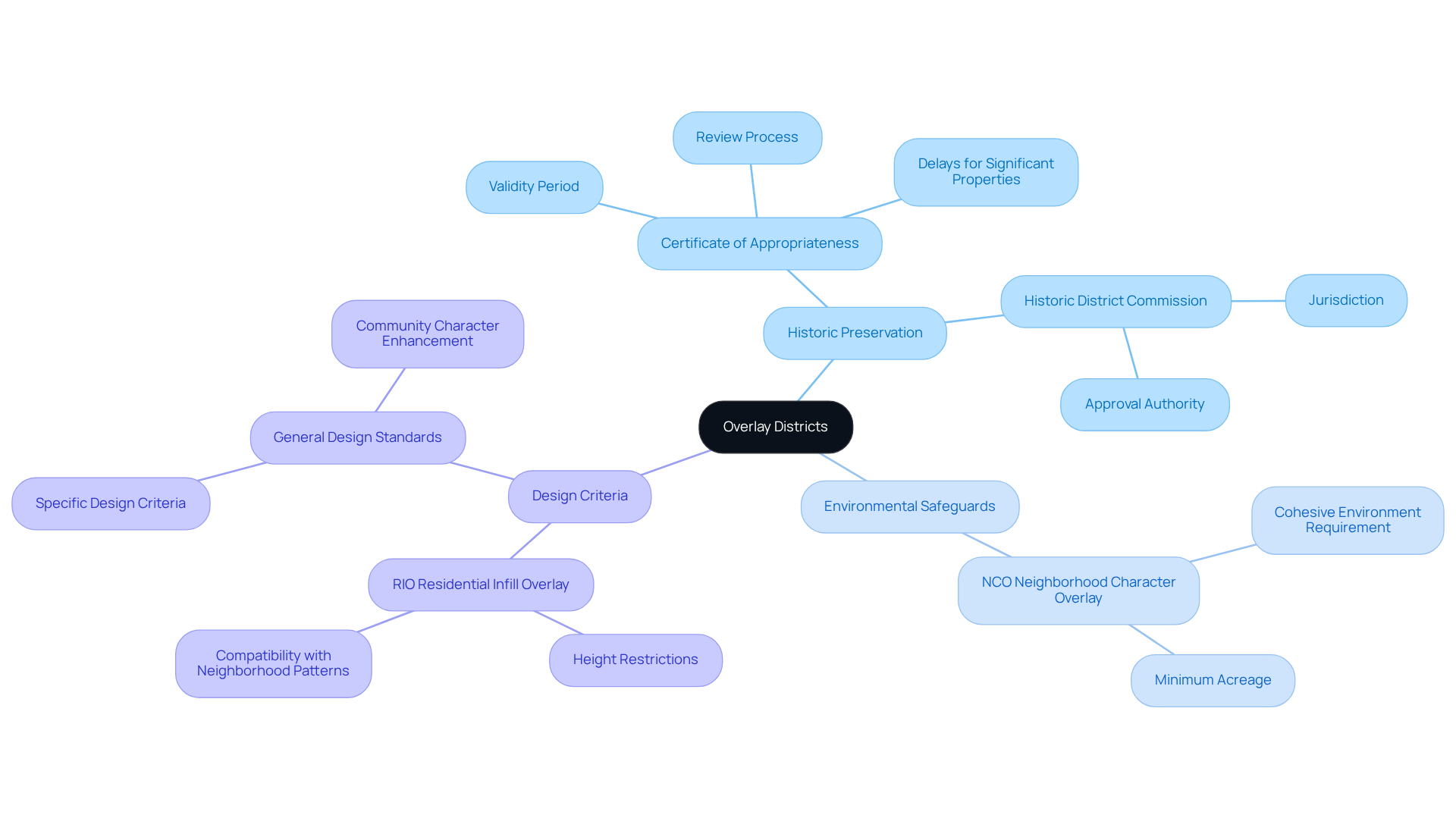
Recent Zoning Changes: Staying Updated on Local Regulations
Zoning regulations are not fixed; they can change due to new legislation, community initiatives, or urban planning efforts, a fact that is crucial in understanding property zoning lookup explained, as these changes significantly impact property values and growth opportunities. Real property experts must remain informed about the property zoning lookup explained changes to ensure compliance and identify new development prospects.
Utilizing tools like Parse AI can simplify the process of tracking land use changes, providing timely updates that inform decision-making. As Robert Kiyosaki aptly states, 'Real estate investing, even on a very small scale, remains a tried and true means of building an individual’s cash flow and wealth.' Staying informed about local land use changes is essential for recognizing new opportunities and effectively adjusting strategies, which is why property zoning lookup explained is crucial.
Furthermore, engaging with community planning committees and leveraging online tools can further assist in remaining updated on land use policy changes. Successful realty professionals understand that flexibility is crucial; as Anthony Hitt highlights, 'To achieve success in realty, you must always and consistently prioritize your clients' best interests.' This proactive approach not only ensures compliance but also positions agents to capitalize on new opportunities as they arise.
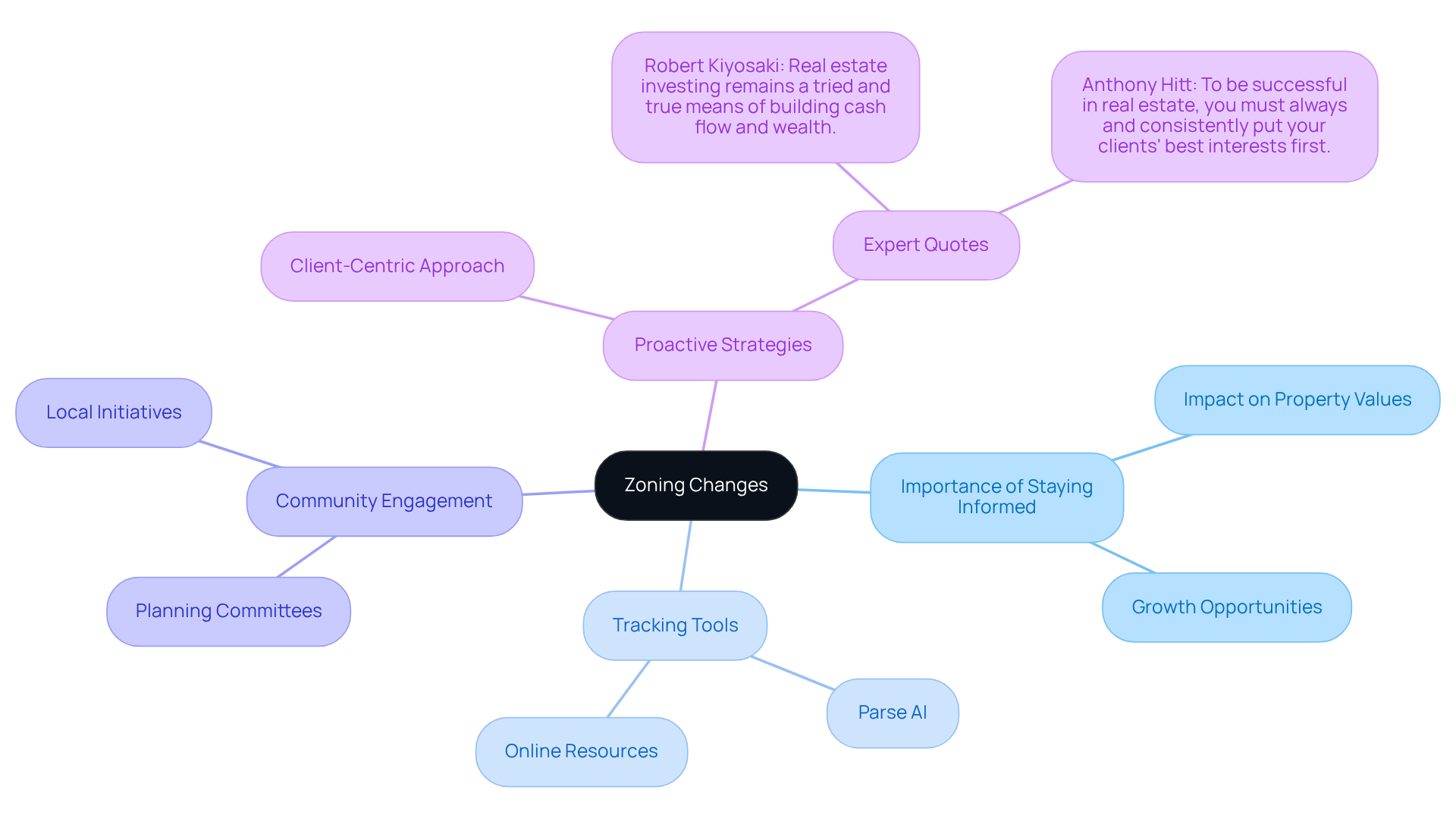
Development Scenarios: Evaluating Potential Uses for Properties
Development scenarios are essential for evaluating potential applications of a property, as property zoning lookup explained by its land use classification and regulations. Real estate experts must thoroughly assess these scenarios to determine the most feasible choices for construction or investment. This examination not only enhances property value but also guarantees compliance with local regulations, which can significantly affect investment choices.
Recent trends indicate a shift towards mixed-use projects and higher-density housing, with Orleans aiming to add 350 attainable housing units in the next 10 years. This reflects a growing demand for vibrant, walkable communities. Furthermore, the commercial corridor between Exit 89 and the Orleans Rotary is emerging as a possible economic center, demonstrating how land-use regulations affect specific regions and opportunities for growth.
Understanding these land use classifications, as detailed in the property zoning lookup explained, is frequently essential for profitable real estate investments since they determine allowable activities and can enhance the appeal of a location. By assessing growth scenarios in light of land-use regulations, experts can make informed choices that align with market needs and regulatory frameworks. However, conventional land-use practices can create obstacles, often limiting progress and necessitating an updated strategy for land planning that meets evolving community needs.
The 'Vision for Orleans Village Center' case study illustrates how land use designations are being employed to foster a lively community, underscoring the significance of such classifications in property investment decisions. As Jan O’Sullivan noted, the planning system is transitioning towards a more coordinated and evidence-based approach, which is essential for fostering sustainable development.
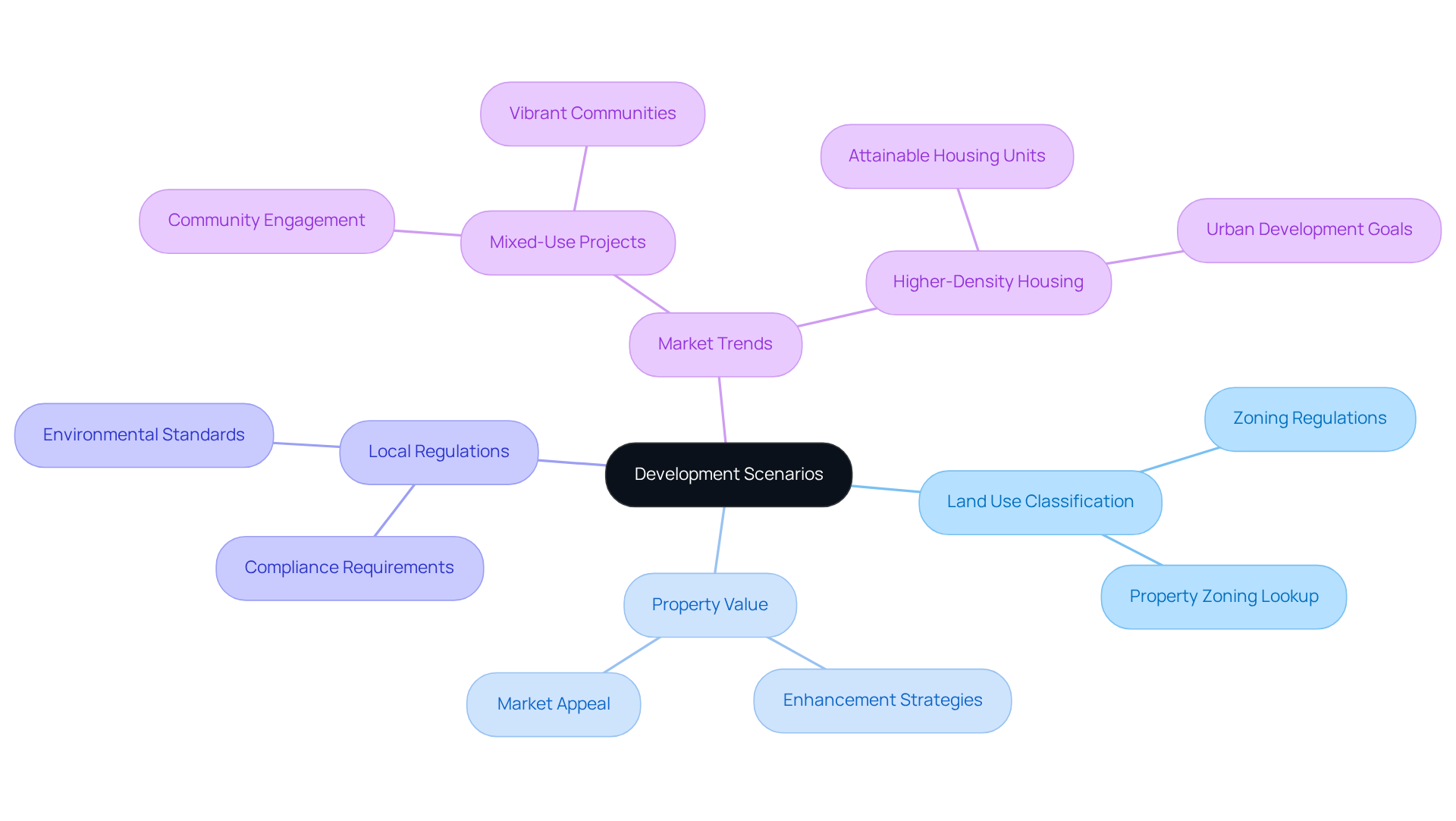
Summarizing Findings: Effective Communication of Zoning Insights
Summarizing findings from land-use research is essential for effective communication among stakeholders, including clients, developers, and regulatory bodies. Real property experts must present land-use insights clearly and concisely, emphasizing key regulations, potential issues, and opportunities. This approach not only fosters informed decision-making but also enhances collaboration throughout the property transaction process.
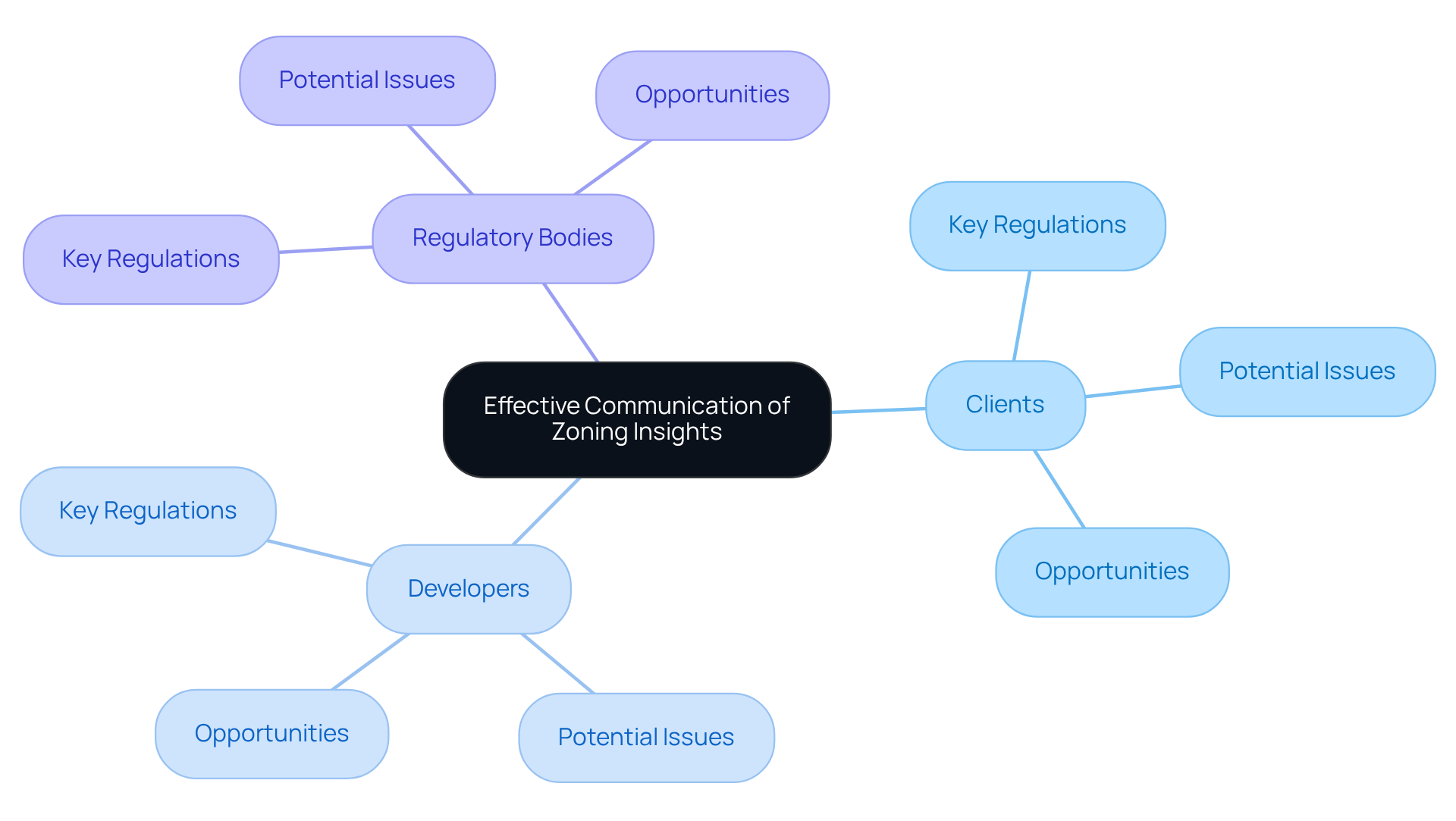
Technology Integration: Enhancing Zoning Lookup Efficiency
Incorporating technology into land use lookup processes, such as utilizing Parse AI, is crucial for enhancing efficiency and precision. By automating data extraction and analysis, property professionals can swiftly obtain pertinent regulatory information, thereby minimizing the time devoted to manual research. Furthermore, this technological integration not only streamlines workflow but also significantly reduces the risk of errors, ensuring compliance with zoning regulations. Consequently, the adoption of such innovations is essential for maintaining a competitive edge in the industry.
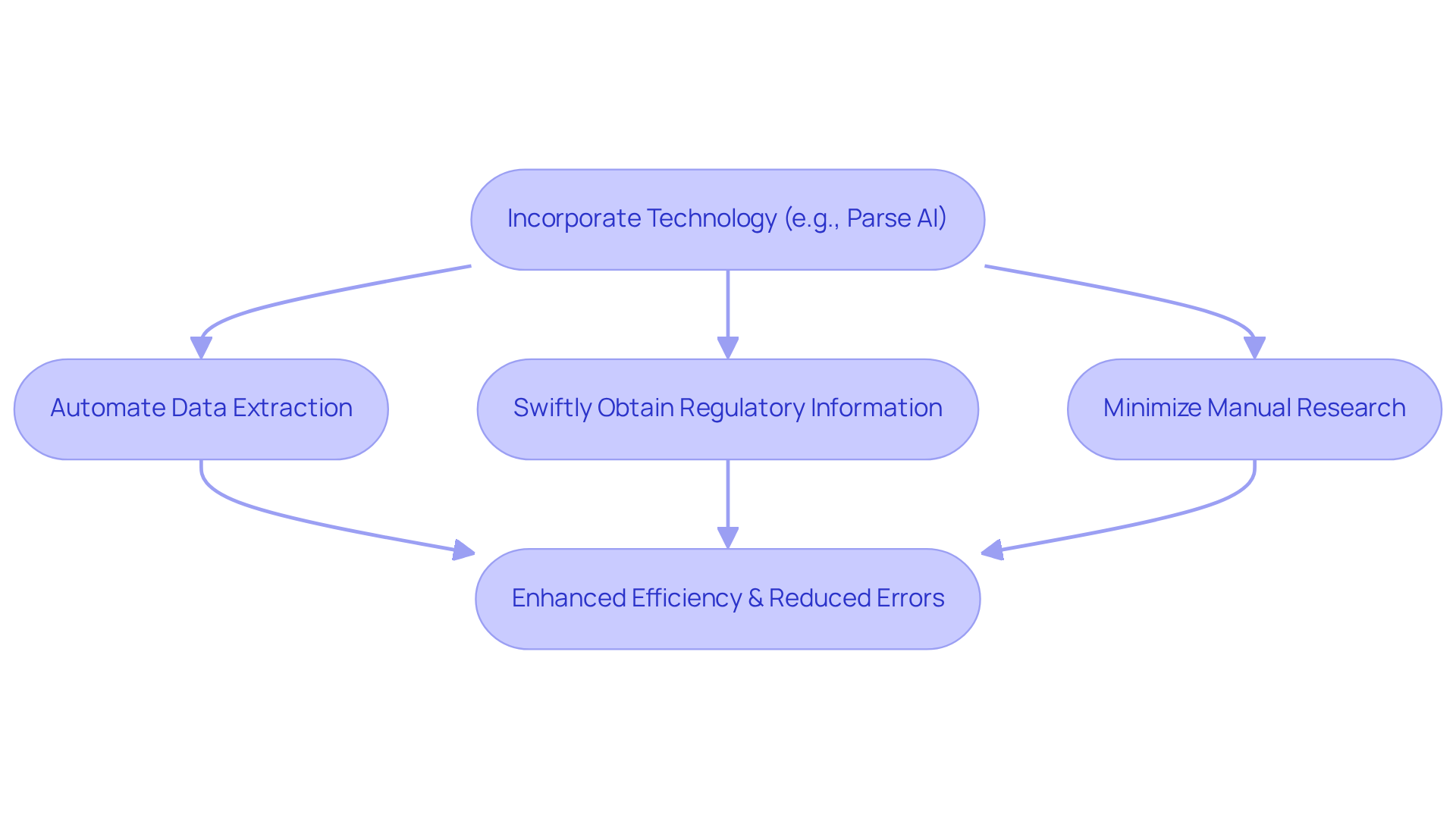
Impact of Zoning Lookup: Influencing Real Estate Decisions
The concept of property zoning lookup explained is pivotal in shaping property decisions, extending well beyond mere compliance. They guide investment strategies and property development plans. Realty experts who grasp the intricacies of land use laws can align their choices with market needs and legal structures, ultimately enhancing property worth. Approximately 70% of real estate professionals consider land-use laws when formulating their investment plans, recognizing that these regulations can dictate project viability and influence potential returns.
For instance, analysts observe that restrictive zoning can deter investment in certain areas, whereas more flexible regulations can attract developers eager to capitalize on emerging markets. Understanding these dynamics is essential for ensuring successful transactions and navigating the complexities of property zoning lookup explained in the context of property development.
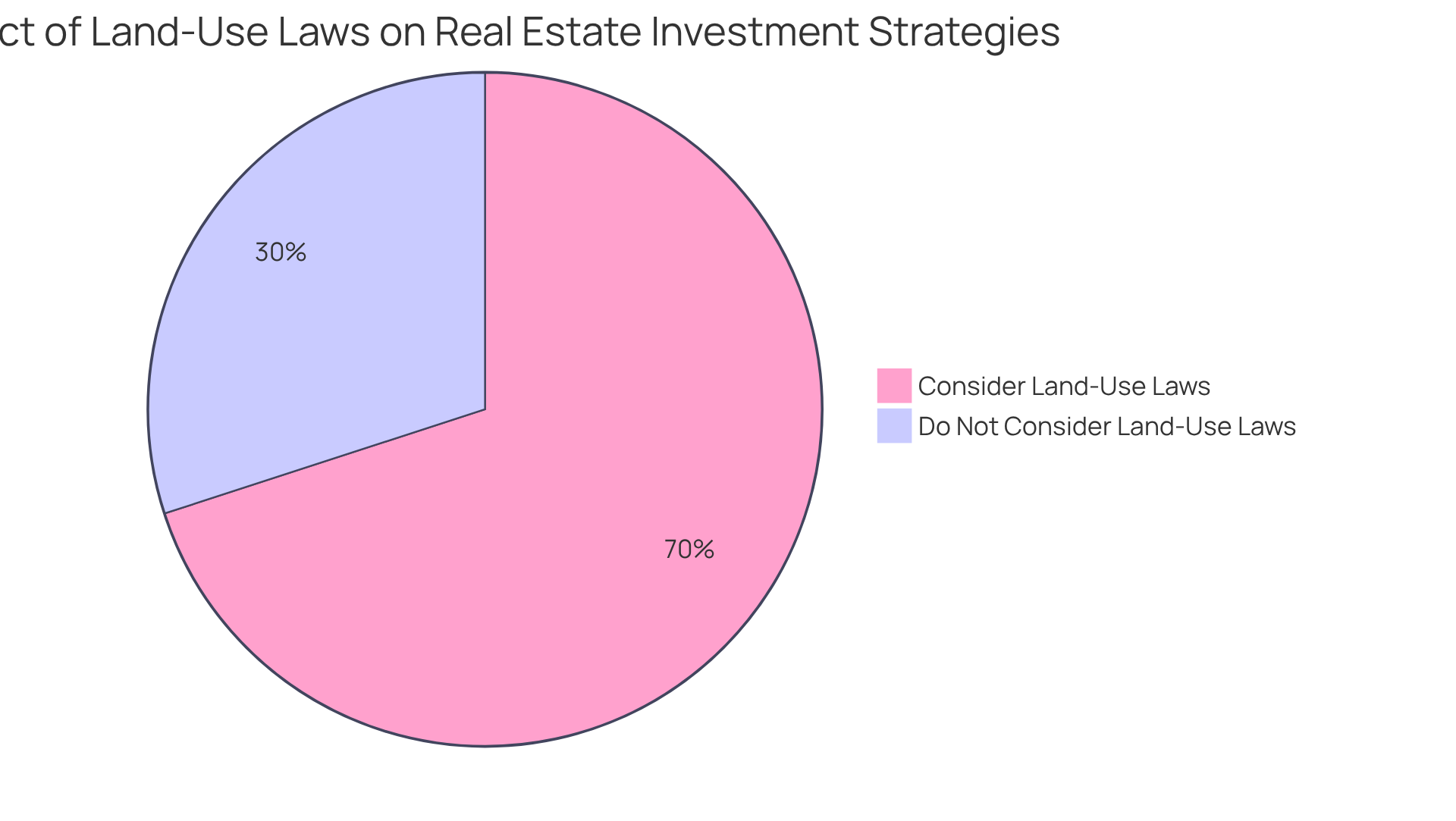
Conclusion
Understanding property zoning is crucial for anyone involved in real estate; it shapes compliance, investment strategies, and development opportunities. This article illuminates how advanced technologies, particularly machine learning, can enhance the efficiency of zoning lookups, ultimately benefiting real estate professionals by saving time and improving decision-making processes.
Recognizing zoning districts, adhering to regulations, and staying updated on recent changes are essential for protecting property values and development potential. The integration of tools like Parse AI exemplifies how technology can streamline zoning research. Furthermore, exploring development scenarios underscores the necessity of aligning property uses with local regulations to maximize investment returns.
The significance of property zoning cannot be overstated. Real estate professionals are encouraged to leverage technology, remain informed about regulatory changes, and effectively communicate zoning insights to stakeholders. By doing so, they can navigate the complexities of the property landscape, capitalize on emerging opportunities, and contribute to sustainable community development.
Frequently Asked Questions
What is Parse AI and how does it assist with property zoning lookups?
Parse AI is a platform that employs advanced machine learning algorithms to automate and accelerate property zoning lookups. It analyzes extensive datasets of land use regulations and property records to identify relevant information, significantly reducing the time spent on manual searches.
Why is the efficiency of Parse AI particularly beneficial for real estate professionals?
The efficiency of Parse AI is beneficial for real estate professionals as it allows for rapid, informed decision-making, which is essential in the fast-paced real estate market.
What recent data highlights the success of automated data collection in zoning?
Recent data from the Connecticut Zoning Atlas indicates that 55.2 percent of all mapped districts were recognized, showcasing the success of automated data collection initiatives.
What partnership aims to enhance the automation of land use data collection?
A partnership with Sara Bronin and the National Zoning Atlas aims to enhance the automation of standardized land use data collection through text analysis and natural language processing techniques.
What role does the Urban Institute's Spatial Equity Data Tool (SEDT) play?
The Urban Institute's Spatial Equity Data Tool (SEDT) plays a pivotal role in enhancing data accessibility for users, making zoning information more readily available.
What challenges exist in extracting standardized land use data?
Challenges include the complexities of extracting standardized land use data from unstandardized documents, which case studies have highlighted. A hybrid approach that combines human expertise with algorithmic methods is recommended.
How do land-use regulations impact critical social issues?
Land-use regulations significantly impact critical issues such as racial equity, housing affordability, and economic development, highlighting the necessity for accurate land-use information for real estate professionals.
What are zoning districts and why are they important?
Zoning districts are designated areas within a municipality that dictate the permissible use of land, including allowable activities, building heights, and density. Understanding these districts is crucial for conducting accurate property zoning lookups and ensuring compliance with local regulations.
What do zoning regulations dictate?
Zoning regulations serve as guidelines for land use within designated districts, dictating parameters such as building setbacks, lot coverage, and allowable activities.
Why is it important for real estate professionals to understand zoning regulations?
Understanding zoning regulations is vital for preventing legal disputes and financial penalties. Familiarity with these standards helps property professionals mitigate risks and ensure their projects align with community expectations.
What should property professionals do to stay informed about zoning regulations?
Property professionals are advised to regularly consult local planning boards or legal advisors to stay informed about any changes in zoning regulations.




